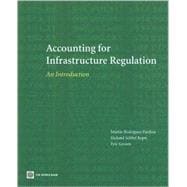
Note: Supplemental materials are not guaranteed with Rental or Used book purchases.
Purchase Benefits
What is included with this book?
| Foreword | p. ix |
| Acknowledgments | p. xi |
| Abbreviations | p. xiii |
| Why Accounting Information Matters | p. 1 |
| Objectives of public service regulation | p. 3 |
| External and internal regulatory information | p. 5 |
| Limitations of traditional accounting information for regulatory purposes | p. 8 |
| Information exchange and participation: The need for processes and mechanisms | p. 12 |
| Case Studies | p. 15 |
| Case study 1: Privatization of an electricity and water operator in Africa-Initial contract not sufficiently specific | p. 15 |
| Case study 2: Regulating operators in Latin America-Manual deficiencies led to inconsistent cost accounting by different utilities | p. 18 |
| Case study 3: Efficient model company regulation in a Latin American country-Deficiencies of benchmarking information and the need for regulatory accounting information | p. 21 |
| Corporate Information and Financial Accounting | p. 27 |
| Corporate information systems | p. 27 |
| Statutory financial statements | p. 29 |
| Additional reading and resources | p. 41 |
| Management and Cost Accounting | p. 43 |
| Objectives of management and cost accounting | p. 43 |
| Cost classifications | p. 45 |
| Cost allocation | p. 53 |
| Additional reading and resources | p. 61 |
| Why Do Regulatory Accounting? | p. 63 |
| Regulatory accounting and its objectives | p. 64 |
| General presentation of information needs | p. 65 |
| Limitations of traditional and management accounting of the regulated company | p. 68 |
| Consistency between statutory accounts and regulatory accounts | p. 69 |
| Regulators' behavior and principles to follow | p. 70 |
| Using accounting costs in tariff determination | p. 71 |
| Regulatory accounting and auditing of regulated companies | p. 77 |
| Additional reading and resources | p. 80 |
| Core Issues in Regulatory Accounting | p. 83 |
| Separation of activities | p. 84 |
| Regulatory asset base determination | p. 92 |
| Depreciation policies of the regulatory asset base | p. 98 |
| Related-party transactions and transfer pricing | p. 102 |
| Additional reading and resources | p. 108 |
| Scope of a Regulatory Accounting System | p. 111 |
| Contents of regulatory accounting guidelines | p. 111 |
| Information exchange processes | p. 121 |
| Need for competencies, tools, and time and methodology | p. 128 |
| Legitimizing the regulatory methodology | p. 131 |
| Additional reading and resources | p. 132 |
| Understanding Financial Statements: Ratio Analysis | p. 135 |
| Liquidity ratio analysis | p. 136 |
| Activity ratios | p. 137 |
| Capital structure (leverage ratios) | p. 138 |
| Profits and profitability | p. 139 |
| Regulatory Model | p. 141 |
| What are regulatory models? | p. 142 |
| Matching regulatory objectives and instruments | p. 146 |
| What regulators need to know about the operator's finances | p. 150 |
| Conclusion | p. 151 |
| Examples of Guidelines and Templates | p. 155 |
| Australia: Electricity Industry Guideline | p. 155 |
| Australia: Regulatory Accounting Statements-Templates | p. 156 |
| United Kingdom: Ofwat Regulatory Accounting Guideline | p. 167 |
| United Kingdom: Ofwat Regulatory Accounting Statements-Templates | p. 167 |
| Impacts of Alternative Depreciation Profiles | p. 175 |
| Perspectives on depreciation | p. 175 |
| Regulatory approaches to depreciation | p. 176 |
| Alternative approaches to depreciation | p. 177 |
| Estimation of asset lives | p. 178 |
| Impact of different approaches to calculating depreciation | p. 179 |
| Data requirements | p. 184 |
| Principles for depreciation | p. 184 |
| List of Sample Performance Indicators | p. 187 |
| Cost Allocation: Illustration of a Step-by-Step Approach | p. 189 |
| Identify cost objectives | p. 189 |
| Identify direct costs | p. 189 |
| Classify indirect costs and allocate cost pools to cost objectives | p. 189 |
| Regulatory Asset Base Valuation | p. 193 |
| Valuation approach | p. 196 |
| Regulatory asset base and accounting | p. 198 |
| Bibliography | p. 205 |
| Index | p. 211 |
| Table of Contents provided by Ingram. All Rights Reserved. |
The New copy of this book will include any supplemental materials advertised. Please check the title of the book to determine if it should include any access cards, study guides, lab manuals, CDs, etc.
The Used, Rental and eBook copies of this book are not guaranteed to include any supplemental materials. Typically, only the book itself is included. This is true even if the title states it includes any access cards, study guides, lab manuals, CDs, etc.